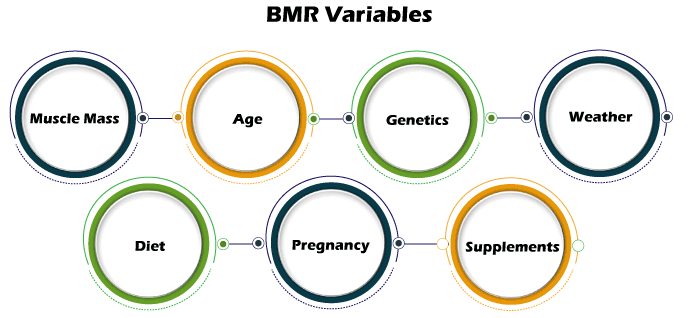What is BMR?Basal metabolic rate (BMR) is the total number of calories that your body burns at rest daily, needs to perform essential and life-sustaining functions. These basal functions include circulation, breathing, cell production, nutrient processing, protein synthesis, and ion transport. Even when you are resting, your body is using energy to function effectively. For example, your body is making your heart pump blood through your veins, and your stomach is processing the food you just ate. This process is better known as your Basal Metabolic Rate. Your body consumes almost 70% of the calories each day due to upkeep. Physical activity makes up 20% of expenditure, and 10% is used to digest food. Calories are also the first metric people take into consideration when losing weight. For most people, upwards of 70% of the BMR is measured under very restrictive circumstances while awake. An accurate BMR measurement requires that a person's sympathetic nervous system is inactive, which means the person must be completely rested. Basal metabolism is usually the most significant component of a person's total caloric needs. The daily caloric need is the BMR value multiplied by a factor with a value between 1.2 and 1.9, depending on activity level. Resting Metabolic Rate (RMR) measures the number of calories that your body burns at rest. Resting metabolic rate is usually measured in the morning before eating or exercising and after a whole night of restful sleep. As you can see, the definitions of RMR and BMR are almost identical. Your resting metabolic rate should be an accurate estimate of your basal metabolic rate. Because the terms are similar, some fitness and weight loss experts use both terms to describe the same thing. But the term "resting metabolic rate" is more common. How to Calculate BMRBMR calculations involve analyzing the amount of oxygen and carbon dioxide a person breathes in and out. Experts refer to this analysis as calorimetry. It is a way of measuring the number of calories a person's body is using. BMR needs some information of the person such as:
According to the American Council on Exercise (ACE), people rarely use BMR outside clinical settings because the test must occur in a tightly controlled environment under stringent testing parameters. As a result, it is unlikely that a person could accurately calculate their BMR at home. The Harris-Benedict Equation is often used to estimate basal metabolic rate.
Variables of BMRBasal metabolism rate has the following variables: 
Metabolic AgeThe metabolic rate changes as people age. Basal metabolism rises as a child matures and peaks at around 16 or 17. After this point, it typically starts to decrease. A low BMR means you have to eat fewer calories to lose body fat and weight. The Metabolic age is calculated by comparing your Basal Metabolic Rate to the average BMR of your chronological age group. If your metabolic age is higher than your actual age, it's a sign that you need to improve your metabolic rate. Increased exercise will build healthy muscle tissue, which in turn will improve your metabolic age. Keeping track of your metabolic age will give you a sign when it's best to gain more muscle mass. Importance of BMRBoth BMR and RMR indicate the number of calories a person burns at rest. This information could be helpful for a person who is trying to manage their weight. If a person is trying to lose weight, calculating their BMR or RMR could help them figure out how many calories to cut out each day. In some cases, this may mean consuming only enough calories to support essential life functions. Or, if a person wants to gain weight, they could use their BMR or RMR calculation to work out how many extra calories to consume each day.
How many calories you need everydayIf you've estimated your BMR using the Harris-Benedict formula, your next step is to include the number of calories you burn during daily activities based on your lifestyle:
The final number is approximately how many calories you need daily to maintain your weight. According to a 2007 study, the formula would be more accurate if it included body composition, weight history, and other factors that have been shown to affect BMR. The U.S. Dietary Guidelines for 2015-2020 provides the following general guidelines on daily calorie intake for men and women:
The guidelines indicate that as a person ages, their BMR will generally decrease. It means that they will require fewer calories than when they were younger.
Next TopicWhat is CBC
|
 For Videos Join Our Youtube Channel: Join Now
For Videos Join Our Youtube Channel: Join Now
Feedback
- Send your Feedback to [email protected]
Help Others, Please Share










